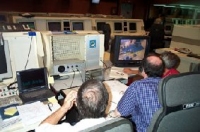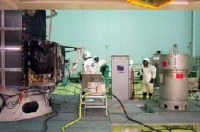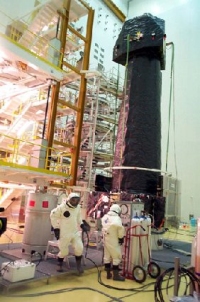Spacecraft Fuelling
17 November 1999
The fuelling of the spacecraft started on Monday 15 November. For this critical operation, XMM had been positioned vertically on a stand inside the special sump area of the Ariane 5 Final Assembly building. XMM had been carefully levelled and connected by flex hoses to the propellant and pressurant loading equipment (PPLE).
Hydrazine is said to have a fishy/ammoniac smell. The propellant is a fuel which becomes flamable and/or explosive when in contact with the air's oxygen or when in proximity of heat sources or of some catalist. The loading of the spacecraft's Reaction and Control System (RCS) therefore involves first evacuating the clean Helium gas in the four tanks and then loading these with the hydrazine. The operation is completed by He pressurisation of the tanks to about 22 bars.
The fuelling was carried out manually by 2 teams of 3 members of the special personnel from Fiat Avio, wearing scapesuits in case of leaks and working in shift.
Monitoring in CDL3
 |
Main parameters being monitored were the mass of the hydrazine loaded in the tanks, the pressure and temperature and the valve position settings.
530 kg for ten years
Over a period of 8 hours, some 530 kgs of hydrazine were transferred to the 4 tanks of the spacecraft. For safety reasons, the spacecraft's electrical systems, as well as part of the electrical power lines inside the BAF had been disconnected during the whole filling operation.
Fuelling operations were completed the next day by a decontamination procedure, making sure that none of the apparatus and the tanks used had any remaining hydrazine, detectable at a level of 0.1 ppm (part per million.)
The spacecraft was reactivated only when the complete PPLE had been removed from the BAF.


